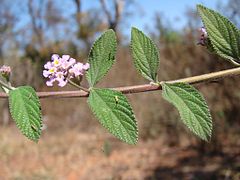 Identification of Lippia adoensis for Access and Benefit sharing
Identification of Lippia adoensis for Access and Benefit sharing
|
Genetic Resources Access and Benefit Sharing Directorate Identification of Lippia adoensis for Access and Benefit sharing Reviewed Dr. Zeleke W/ Tenssay
Lippia adoensis March 9, 2016 1. Introduction The Ethiopian Biodiversity Institute (EBI) is the national competent authority with ABS directorate playing the opertionalizing role of the Nagoya protocol on Accesss and Benefit sharing of genetic resources and associated traditional knowledge. The country has the legal frame work for the implementation of the ABS. The laws regarding the national Access and Benefit Sharing legal frame work is the proclamation on access to genetic resources and community knowledge and community right Proclamation No 482/2006 and regulation Number 169/2009. Based on these laws Ethiopia has implemented the CBD third objective Access to genetic resources and sharing fair and equitable benefit from the use of the genetic resources and associated knowledge. The country has wealth of biodiversity and associated traditional knowledge from which it can be benefited by providing to bio-prospecting companies. Especially the medicinal plants and the traditional knowledge is a potential area for bio-prospecting and for ABS. In this line The Access and Benefit Sharing Directorate of EBI is playing a proactive role to introduce the potential genetic resources for bio-prospecting. Therefore the aim of this information is to introduce one of the locally popular medicinal plants endemic to Ethiopia which is known as Lippia adoensis var koserete. 2. The Plant Lippia adoensis Hochst also known as L. multiflora is a herbaceous plant of the genus Lippia. It belongs to the family Verbanaceae, which is composed of 41 genera with approximately 220 species of herbs, shrubs and small trees (1, 2, 3). The plant flowers from September to November and fruits in January. It possesses white sweet-scented flowers stalked on cone-like heads in a terminal panicle nearly 120 mm long (4,5, 6,7). Lippia species in Ethiopia occurs as an erect woody shrub which grows up to 1-3m tall, It is endemic medicinal plant and cultivated variety commonly found in home gardens in different regions of Ethiopia with altitudinal range of 1600-2200m. Two varieties are recognized in Ethiopia, the wild variety (var. adoensis) and the cultivated variety locally known as koseret (var. koseret sebsebe). .2.1. Distribution Lippia adoensis is mainly distributed throughout tropical Africa, South and Central American countries (8). It occurs in a wide ecological range throughout West Africa .L. adoensis var. koseret sebsebe widely grown in the central and southern highlands of Ethiopia (9, 10).
2.2. Ethno-medicinal uses Traditionally, the dried leaves are used as one of the ingredients in the preparation of spiced butter (9) and also for food flavoring agent and preservative. The leaves of L. adoensis are used in Ethiopian traditional medicine for the treatment of various skin diseases including eczema and superficial fungal infections [9,10). The dried leaves powdered together with barely eaten to get relief to from stomach complaints. 3. Chemical compositions and Pharmacological Activities 3.1. Chemical composition The essential oil of L. adoensis which is typically yellow has been extracted and characterized by various workers. This may have been motivated by the very wide traditional use of the oil for both therapeutic and non-therapeutic purposes. The most exploited mode of oil extraction and characterization is hydrodistillation and Gas Chromatography-Mass Spectrometry (GCMS) respectively. Reports of studies from literature show that there exists a great degree of variability in the chemical composition of the oil which may have been due to a number of interacting factors such as ecological origin, environmental factors like stress (soil type, humidity, mechanical damage and cultures) as well as genetic factors (3). This wide variability in the chemical composition of the oil calls for caution in the therapeutic and nontherapeutic (cosmetic, nutritive) application of the oil.
Many researchers have also reported various pharmacological properties of the plant extract and its essential oil. These reports have confirmed some of the traditional therapeutic uses of the plant. Some of these reports have also traced these pharmacological activities to some specific chemical constituents of the essential oil (11). 3.2.The essential oil of lippia adoensis Phytochemical studies by several researchers have shown the presence of essential or volatile oil in the aerial part of L. adoensis, which has been extracted and characterized by some workers using hydrodistillation and Gas Chromatography-Mass Spectrometry (GCMS). Others have also used traditional classical methods of maceration in organic solvents to isolate the oil or components of the oil and then characterize by using GCMS and other spectrometric methods like Nuclear Magnetic Resonance (NMR) and Infra-Red spectrometry (2, 3, and 7). The oil which is believed traditionally to possess some pharmaco-therapeutic activities has been widely studied by investigators in the field. Some of these pharmacological activities have been confirmed while others are still ongoing due to conflicting results by different researchers. However, it is widely reported that the lippia oil vary greatly in chemical composition and also to an extent in physical properties like refractive index and density, probably due to geographic factors and genetic makeup (3). The extent of the influence of these two factors on the physicochemical composition of the oil is yet to be scientifically investigated. 4. Antimicrobial properties Recent scientific investigations revealed that essential oil hydrodistilled from leaves of L. adoensis possess antimicrobial properties. In a study by Oladimeji (12), it was revealed that fungi were more susceptible to the Lippia adoensis oil than bacteria. In the review work by Gemeda and Woldeamanuel (9) the oil exhibited strong inhibitory effect on the growth of Staphylococcus aureus and Enterococcus hirae, and a moderate effect was observed for Candida albicans and Saccharomyces cerevisiae (10). The report went further to suggest elemol, 1,8-cineole, camphor and para-cymene as the principal antimicrobial components of this oil. 5. Prospects Thus the components L. adoensis oil are known to possess potent antimicrobial and antispasmodic activities (13,14). The economic prospect of the exploitation of Lippia oil appears largely viable if well investigated and optimized. More work should be done in standardizing the chemotyping criteria and processes. Most of the studies currently ongoing are on wild variant of the plant and efforts should be made at developing cultivated species to improve yield of selected chemical components in order to effectively undertake economic scale cultivation. 6. Reference 1. Evans WC. Trease & Evans (1989). Pharmacology. Bailliare TindallLondon 378-480. 2. Jigam AA, Akanya HO, Ogbadoyi EO, Dauda BEN, Egwim CE. (2009) In vivo antiplasmodial, analgesic and anti-inflammatory activities of the leaf extract of Lippia multiflora mold. J Med Plants Res. 3(3): 148-154. 3. Owolabi MS, Ogundajo A, Lajide L, Oladimeji MO, Setzer WN, Palazzo MC(2009). Chemical Composition and Antibacterial Activity of the Essential Oil of Lippia multiflora Moldenke from Nigeria. Rec Nat Prod. 3(4): 170-177. 4. Irvine FR. (1961). Woody plants of Ghana. Oxford University Press London 758 – 759. 5. Acquaye D, Smith M, Letchamo W and Simon J. (2001). Lippia tea Centre for New Use Agriculture and Natural Products. Rutgers University, New Brunswick, New Jersey, USA 6. Munir AA. A.(1993). Taxonomic revision of the genus Lippia (Verbanacea) in Australia.. J Adelaide Bot Garden. 15: 129 – 145. 7. Kunle OF. (2000). Phytochemical and microbiological studies of the leafof Lippia mutiflora Mold., Fam Verbenaceae. Unpublished Ph.D dissertation of the Ahmadu Bello University, Zaria, Kaduna State, Nigeria. 8.Pascual ME, Slowing K, Carretero E, Sánchez Mata D, Villar A.( 2001). Lippia: traditional uses, chemistry and pharmacology: a review. J. Ethnopharmacol; 76: 201-214. 9.Gemeda, N. Woldeamanuel, Y.; Asrat, D.; Debella, A.; Belete, Y., (2015). Assessment of lippia adoensis hochst. var. koseret, rosmarinus officinalis l. and ruta chalepensis l. essential oils as a potential source of fungitoxic and mycosporicidal activity against toxigenic aspergillus species. Pharmacology on Line vol.2 • 85-94. 10. Gemechu Ameya Buli, Abdella Gure Duga, Engda Dessalegn (2015). Antimicrobial Activity of Lippia adoensis var. koseret Against Human Pathogenic Bacteria and Fungi. American Journal of Clinical and Experimental Medicine 3(3): 118-123. 11. Abena AA, Atipo-Ebata JK, Hondi AT, Diatewa M.( 2001). Psychopharmacological properties of crude extract and essential oil of Lippia multiflora.. Encephale. 27(4): 360-364 12. Oladimeji FA, Orafidiya OO, Ogunniyi TAB, Adewunmi TA. (2000).Pediculocidal and scabicidal properties of Lippia multiflora essential oil. J. Ethnopharmacol. 72, 305-311. 13. Mwangi JW. (1990). Pharmacognostical and biological studies of Kenyan Lippia species with special reference to their essential oil content. Ph.D. thesis, University of Nairobi, Kenya 14. Addea-Mensah I. (1992). Towards a rational Scientific Basis for Herbal Medicine. A Phytochemist’s Two Decade Contribution. Ghana University Press, Accra.
|
| Release date | 19/07/2016 |
|---|---|
| Contributor | IT Team EBI |
| Geographical coverage | Identification of Lippia adoensis for Access and Benefit sharing |
| Keywords | Lippia adoensis |
Please note that this information has expired.

